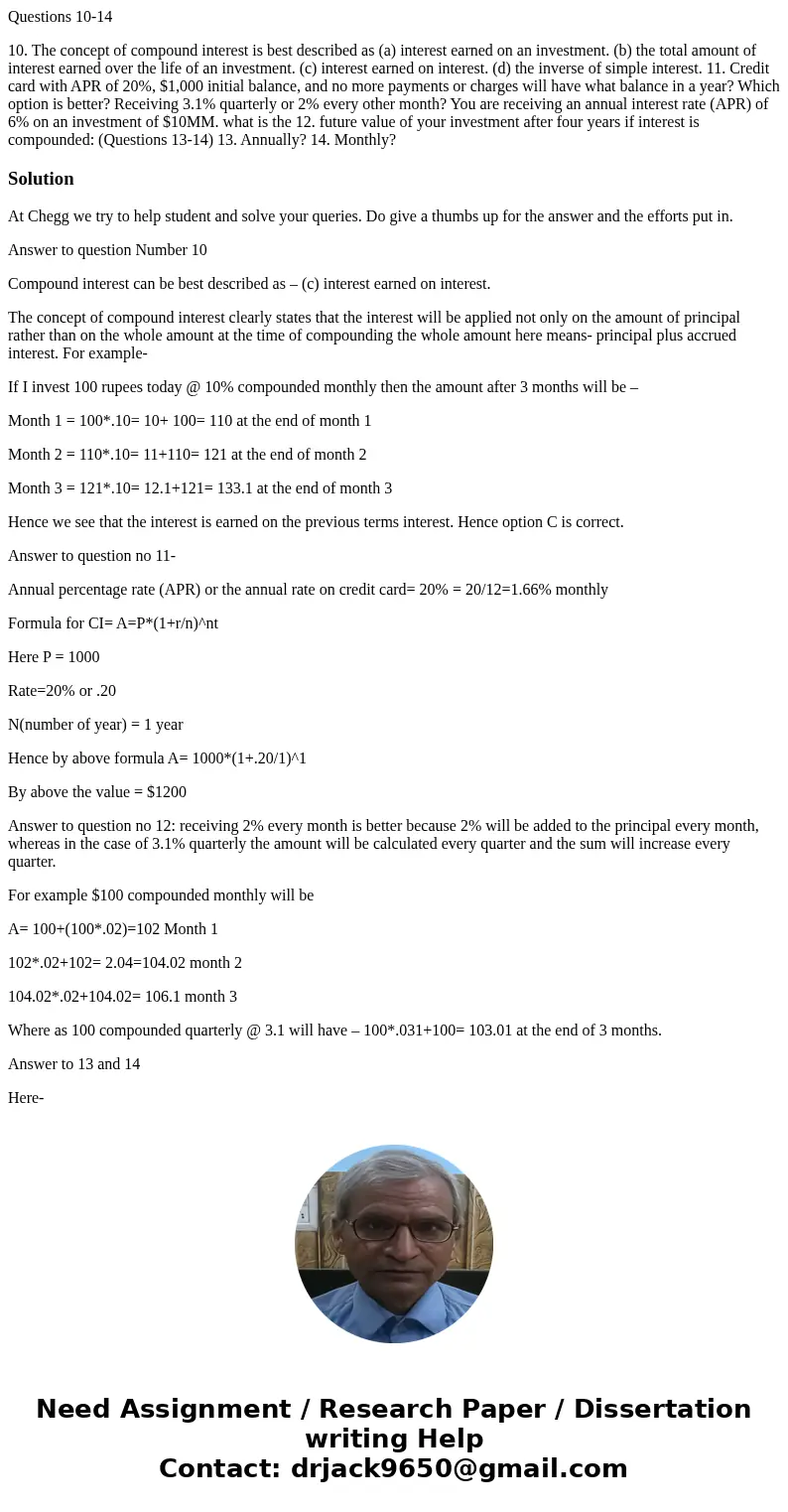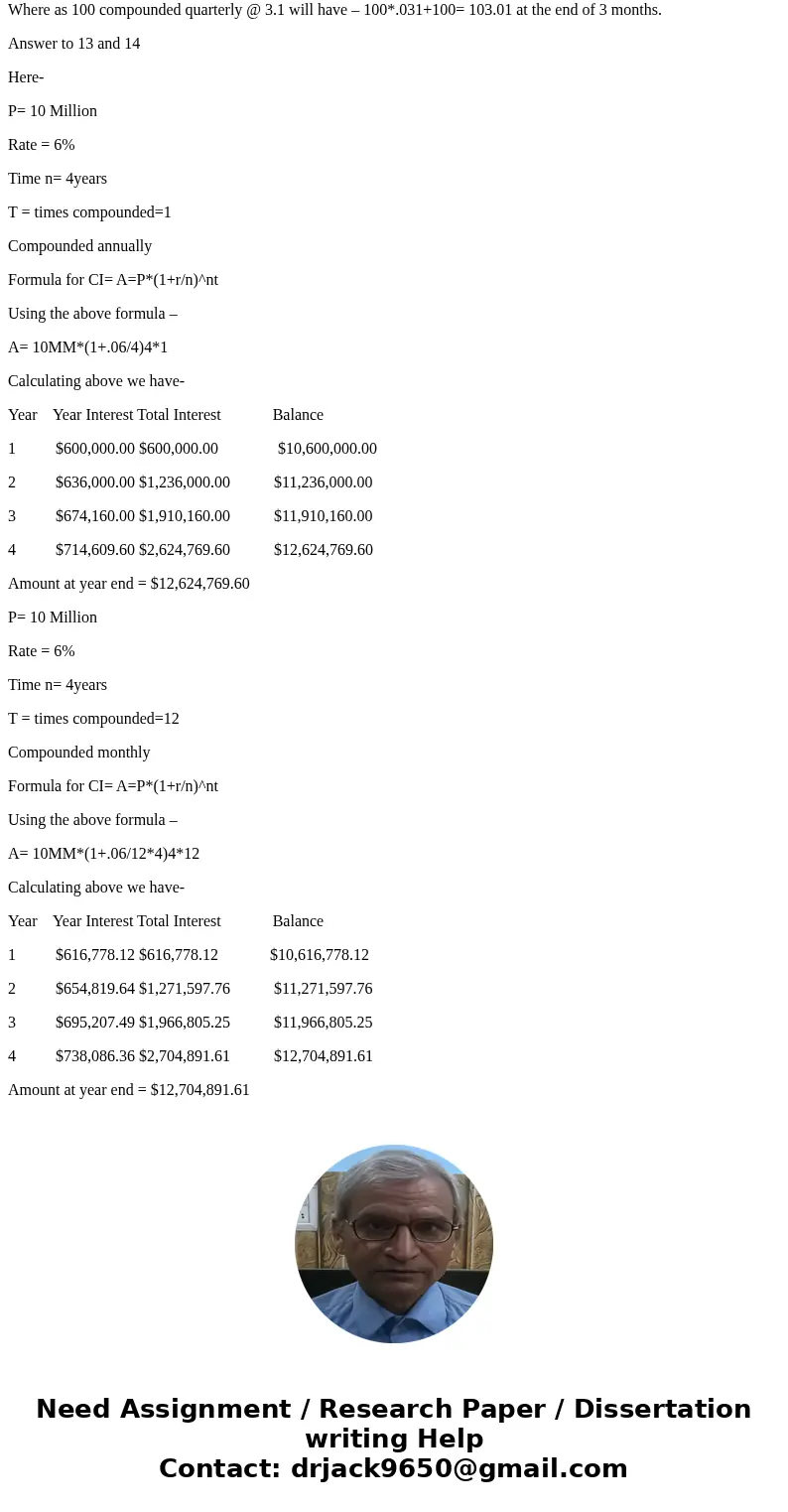Questions 1014 10 The concept of compound interest is best d
Questions 10-14
10. The concept of compound interest is best described as (a) interest earned on an investment. (b) the total amount of interest earned over the life of an investment. (c) interest earned on interest. (d) the inverse of simple interest. 11. Credit card with APR of 20%, $1,000 initial balance, and no more payments or charges will have what balance in a year? Which option is better? Receiving 3.1% quarterly or 2% every other month? You are receiving an annual interest rate (APR) of 6% on an investment of $10MM. what is the 12. future value of your investment after four years if interest is compounded: (Questions 13-14) 13. Annually? 14. Monthly?Solution
At Chegg we try to help student and solve your queries. Do give a thumbs up for the answer and the efforts put in.
Answer to question Number 10
Compound interest can be best described as – (c) interest earned on interest.
The concept of compound interest clearly states that the interest will be applied not only on the amount of principal rather than on the whole amount at the time of compounding the whole amount here means- principal plus accrued interest. For example-
If I invest 100 rupees today @ 10% compounded monthly then the amount after 3 months will be –
Month 1 = 100*.10= 10+ 100= 110 at the end of month 1
Month 2 = 110*.10= 11+110= 121 at the end of month 2
Month 3 = 121*.10= 12.1+121= 133.1 at the end of month 3
Hence we see that the interest is earned on the previous terms interest. Hence option C is correct.
Answer to question no 11-
Annual percentage rate (APR) or the annual rate on credit card= 20% = 20/12=1.66% monthly
Formula for CI= A=P*(1+r/n)^nt
Here P = 1000
Rate=20% or .20
N(number of year) = 1 year
Hence by above formula A= 1000*(1+.20/1)^1
By above the value = $1200
Answer to question no 12: receiving 2% every month is better because 2% will be added to the principal every month, whereas in the case of 3.1% quarterly the amount will be calculated every quarter and the sum will increase every quarter.
For example $100 compounded monthly will be
A= 100+(100*.02)=102 Month 1
102*.02+102= 2.04=104.02 month 2
104.02*.02+104.02= 106.1 month 3
Where as 100 compounded quarterly @ 3.1 will have – 100*.031+100= 103.01 at the end of 3 months.
Answer to 13 and 14
Here-
P= 10 Million
Rate = 6%
Time n= 4years
T = times compounded=1
Compounded annually
Formula for CI= A=P*(1+r/n)^nt
Using the above formula –
A= 10MM*(1+.06/4)4*1
Calculating above we have-
Year Year Interest Total Interest Balance
1 $600,000.00 $600,000.00 $10,600,000.00
2 $636,000.00 $1,236,000.00 $11,236,000.00
3 $674,160.00 $1,910,160.00 $11,910,160.00
4 $714,609.60 $2,624,769.60 $12,624,769.60
Amount at year end = $12,624,769.60
P= 10 Million
Rate = 6%
Time n= 4years
T = times compounded=12
Compounded monthly
Formula for CI= A=P*(1+r/n)^nt
Using the above formula –
A= 10MM*(1+.06/12*4)4*12
Calculating above we have-
Year Year Interest Total Interest Balance
1 $616,778.12 $616,778.12 $10,616,778.12
2 $654,819.64 $1,271,597.76 $11,271,597.76
3 $695,207.49 $1,966,805.25 $11,966,805.25
4 $738,086.36 $2,704,891.61 $12,704,891.61
Amount at year end = $12,704,891.61


 Homework Sourse
Homework Sourse